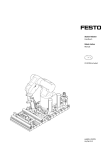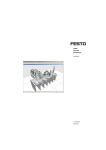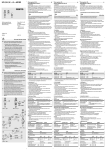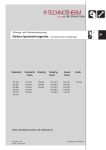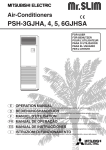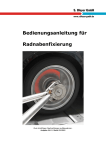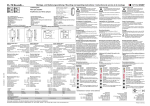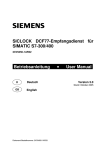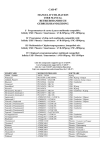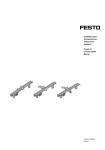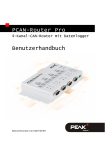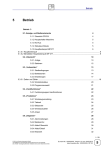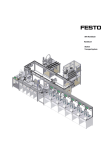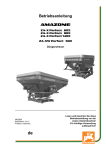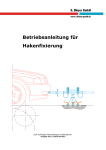Download Handbuch Station Puffern
Transcript
Station Trennen Handbuch Separating station Manual CD-ROM included 696682 DE/EN 04/06 R2.2 Bestimmungsgemäße Verwendung/Intended use Diese Station ist ausschließlich für die Aus- und Weiterbildung im Bereich Automatisierung und Kommunikation entwickelt und hergestellt. Das Ausbildungsunternehmen und/oder die Ausbildenden hat/haben dafür Sorge zu tragen, dass die Auszubildenden die Sicherheitsvorkehrungen, die in den begleitenden Handbüchern beschrieben sind, beachten. Festo Didactic schließt hiermit jegliche Haftung für Schäden des Auszubildenden, des Ausbildungsunternehmens und/oder sonstiger Dritter aus, die bei Gebrauch/Einsatz der Anlage außerhalb einer reinen Ausbildungssituation auftreten; es sei denn Festo Didactic hat solche Schäden vorsätzlich oder grob fahrlässig verursacht. This station has been developed and produced solely for vocational and further training purposes in the field of automation and communication. The company undertaking the training and/or the instructors is/are to ensure that trainees observe the safety precautions described in the manuals provided. Festo Didactic herewith excludes any liability for damage or injury caused to trainees, the training company and/or any third party, which may occur if the system is in use for purposes other than purely for training, unless the said damage/injury has been caused by Festo Didactic deliberately or through gross negligence. Bestell-Nr. / Order No.: Benennung / Description: Bezeichnung / Designation: Stand / Status: Autoren / Authors: Grafik / Graphics: Layout / Layout: 696682 TECH.DOKUMENT. D:MP-TD-TR-DE/EN 04/2006 Frank Ebel, Markus Pany Doris Schwarzenberger, Albert Sigel 04/2006 © Festo Didactic GmbH & Co. KG, D-73770 Denkendorf, 2006 Internet: www.festo-didactic.com e-mail: [email protected] Weitergabe sowie Vervielfältigung dieses Dokuments, Verwertung und Mitteilung seines Inhalts verboten, soweit nicht ausdrücklich gestattet. Zuwiderhandlungen verpflichten zu Schadenersatz. Alle Rechte vorbehalten, insbesondere das Recht, Patent-, Gebrauchsmuster- oder Geschmacksmusteranmeldungen durchzuführen. The copying, distribution and utilisation of this document as well as the communication of its contents to others without express authorisation is prohibited. Offenders will be held liable for the payment of damages. All rights reserved, in particular the right to carry out patent, utility model or ornamental design registration. 2 © Festo Didactic GmbH & Co. KG • 696682 Inhalt/Contents 1. 1.1 1.2 1.3 1.4 1.5 1.6 1.7 Einleitung ____________________________________________________ 7 Lerninhalte ____________________________________________________ 8 Wichtige Hinweise ______________________________________________ 9 Verpflichtung des Betreibers _____________________________________ 9 Verpflichtung der Auszubildenden _________________________________ 9 Gefahren im Umgang mit dem Modularen Produktions-System_________ 10 Gewährleistung und Haftung ____________________________________ 11 Bestimmungsgemäße Verwendung _______________________________ 11 2. Sicherheitshinweise ___________________________________________ 13 3. 3.1 Technische Daten _____________________________________________ 15 Kombinationen________________________________________________ 15 4. Transport/Auspacken/Lieferumfang______________________________ 17 5. 5.1 5.1.1 5.1.2 5.2 5.3 5.4 5.5 5.6 Aufbau und Funktion___________________________________________ Die Station Trennen ____________________________________________ Aufbau als Einzelstation ________________________________________ Aufbau mit Folgestation(en) _____________________________________ Funktion _____________________________________________________ Ablaufbeschreibung ___________________________________________ Modul Unterscheiden __________________________________________ Modul Verzweigen _____________________________________________ Modul Weiche, pneumatisch_____________________________________ 19 19 21 22 23 23 25 26 27 6. 6.1 6.2 6.2.1 6.3 6.3.1 6.3.2 6.3.3 6.3.4 6.4 Inbetriebnahme_______________________________________________ Arbeitsplatz __________________________________________________ Mechanischer Aufbau __________________________________________ Montage von Profilplatte und Bedienpult __________________________ Sensoren justieren_____________________________________________ Näherungsschalter, induktiv (Modul Weiche) _______________________ Reflex-Lichttaster (Modul Verzweigen, Werkstücknachweis) ___________ Reflex-Lichttaster (Modul Unterscheiden, Werkstückidentifikation) _____ Einweg-Lichtschranke (Modul Verzweigen, Werkstücknachweis) _______ Sichtprüfung _________________________________________________ 29 29 30 30 31 31 32 33 34 35 © Festo Didactic GmbH & Co. KG • 696682 3 Inhalt/Contents 6.5 6.6 6.6.1 6.7 6.8 6.8.1 6.8.2 6.8.3 6.8.4 6.8.5 6.9 6.10 6.10.1 6.10.2 Kabelverbindungen ____________________________________________ Pneumatischer Anschluss _______________________________________ Handhilfsbetätigung (HHB) ______________________________________ Spannungsversorgung _________________________________________ SPS Programm laden ___________________________________________ Siemens Steuerungen __________________________________________ Siemens Steuerung mit Analog-Baugruppe _________________________ Festo Steuerungen_____________________________________________ Allen Bradley Steuerungen ______________________________________ Mitsubishi/MELSEC Steuerungen_________________________________ Ablauf starten ________________________________________________ Kombination von Stationen______________________________________ Vernetzung___________________________________________________ Hardwareanpassungen _________________________________________ 7. Wartung _____________________________________________________ 53 Inhalt der CD-ROM ___________________________________________________ Schaltpläne __________________________________________________ Programmierung ______________________________________________ Bedienungsanleitungen ________________________________________ Datenblätter__________________________________________________ 36 37 37 37 38 38 41 44 46 49 51 52 52 52 55 55 55 55 56 Aktualisierungen ____________________________________________________ 57 4 © Festo Didactic GmbH & Co. KG • 696682 Inhalt/Contents Contents __________________________________________________________ 59 1. 1.1 1.2 1.3 1.4 1.5 1.6 1.7 Introduction __________________________________________________ Training contents ______________________________________________ Important notes _______________________________________________ Duty of the operating authority___________________________________ Duty of trainees _______________________________________________ Risks involved in dealing with the Modular Production System _________ Warranty and liability __________________________________________ Intended use _________________________________________________ 2. Notes on safety _______________________________________________ 67 3. 3.1 Technical data ________________________________________________ 69 Combinations_________________________________________________ 69 4. Transport/Unpacking/Scope of delivery __________________________ 71 5. 5.1 5.1.1 5.1.2 5.2 5.3 5.4 5.5 5.6 Design and function ___________________________________________ The Separating station _________________________________________ Setup for use as an individual station _____________________________ Setup with subsequent station(s)_________________________________ Function _____________________________________________________ Sequence description __________________________________________ Differentiation module _________________________________________ Branching module _____________________________________________ Sorting gate module, pneumatic _________________________________ 73 73 75 76 77 77 79 80 81 6. 6.1 6.2 6.2.1 6.3 6.3.1 6.3.2 6.3.3 6.3.4 6.4 Commissioning _______________________________________________ Workstation __________________________________________________ Mechanical set up _____________________________________________ Assembling profile plate and control console _______________________ Adjust sensors ________________________________________________ Inductive proximity sensor (Sorting gate module)____________________ Diffuse sensor (Branching module, detection of workpieces)___________ Diffuse sensor (Differentiation module, identification of workpieces) ____ Through-beam sensor (Branching module, detection of workpieces) ____ Visual check __________________________________________________ 83 83 84 84 85 85 86 87 88 89 © Festo Didactic GmbH & Co. KG • 696682 61 62 63 63 63 64 65 65 5 Inhalt/Contents 6.5 6.6 6.6.1 6.7 6.8 6.8.1 6.8.2 6.8.3 6.8.4 6.8.5 6.9 6.10 6.10.1 6.10.2 Cable connections _____________________________________________ 90 Pneumatic connection __________________________________________ 91 Manual override_______________________________________________ 91 Voltage supply ________________________________________________ 91 Loading the PLC program _______________________________________ 92 Siemens controller_____________________________________________ 92 Siemens controller with analog module ____________________________ 95 Festo controller _______________________________________________ 98 Allen Bradley controller ________________________________________ 100 Mitsubishi/MELSEC controller __________________________________ 103 Starting the sequence _________________________________________ 105 Combination of stations _______________________________________ 106 Networking__________________________________________________ 106 Hardware modifications _______________________________________ 106 7. Maintenance ________________________________________________ 107 Content of the CD-ROM ______________________________________________ Circuit diagrams______________________________________________ Programming ________________________________________________ Operating instructions_________________________________________ Data sheets _________________________________________________ Updates 6 109 109 109 109 110 _________________________________________________________ 111 © Festo Didactic GmbH & Co. KG • 696682 1. Einleitung Das Lernsystem Automatisierung von Festo Didactic orientiert sich an unterschiedlichen Bildungsvoraussetzungen und beruflichen Anforderungen. Die Anlagen und Stationen des Modularen Produktions-Systems (MPS®) ermöglichen eine an der betrieblichen Realität ausgerichtete Aus- und Weiterbildung. Die Hardware setzt sich aus didaktisch aufbereiteten Industriekomponenten zusammen. Die Station Trennen liefert Ihnen ein geeignetes System, mit dem Sie die neuen Schlüsselqualifikationen • Sozialkompetenz, • Fachkompetenz und • Methodenkompetenz praxisorientiert vermitteln können. Zusätzlich können Teamfähigkeit, Kooperationsbereitschaft und Organisationsvermögen trainiert werden. In Lernprojekten können die realen Projektphasen geschult werden. Hierzu gehören: • • • • • • • Planung, Montage, Programmierung, Inbetriebnahme, Betrieb, Wartung und Fehlersuche. © Festo Didactic GmbH & Co. KG • 696682 7 1. Einleitung 1.1 Lerninhalte Lerninhalte aus den folgenden Bereichen können bearbeitet werden: • Mechanik – Mechanischer Aufbau einer Station • Pneumatik – Verschlauchen pneumatischer Komponenten • Elektrotechnik – Fachgerechtes Verdrahten elektrischer Komponenten – Anschluss von DC-Motoren • Sensorik – Funktionsweise und Einsatzgebiete optischer und induktiver Sensoren mit digitalem Schaltverhalten – Funktionsweise und Einsatzgebiete analoger Sensoren am Beispiel eines optoelektronischen Distanzsensors zur Abstandsmessung • SPS – Programmieren und Einsatz einer SPS – Programmieren von Alternativ- (ODER-) Verzweigungen – Struktur eines SPS-Programms – Analogsignal-Verarbeitung • Inbetriebnahme – Inbetriebnahme einer Fertigungsanlage • Fehlersuche – Systematische Fehlersuche an einer Fertigungsanlage Themen für Projektarbeiten • Auswahl und Einsatz verschiedener elektrischer Antriebe – Antriebsmotor Band • Ersetzen der pneumatischen Komponenten durch elektrische Komponenten • SPS Programmierung – Programmieren von Zählern – Programmieren eines Zwischenspeichers für Werkstückparameter – Programmieren eines Betriebsartenteils – Programmieren des RICHTEN Ablaufs 8 © Festo Didactic GmbH & Co. KG • 696682 1. Einleitung 1.2 Wichtige Hinweise Grundvoraussetzung für den sicherheitsgerechten Umgang und den störungsfreien Betrieb des MPS® ist die Kenntnis der grundlegenden Sicherheitshinweise und der Sicherheitsvorschriften Dieses Handbuch enthält die wichtigsten Hinweise, um das MPS® sicherheitsgerecht zu betreiben. Insbesondere die Sicherheitshinweise sind von allen Personen zu beachten, die am MPS® arbeiten. Darüber hinaus sind die für den Einsatzort geltenden Regeln und Vorschriften zur Unfallverhütung zu beachten. 1.3 Verpflichtung des Betreibers Der Betreiber verpflichtet sich, nur Personen am MPS® arbeiten zu lassen, die: • mit den grundlegenden Vorschriften über Arbeitssicherheit und Unfallverhütung vertraut und in die Handhabung des MPS® eingewiesen sind, • das Sicherheitskapitel und die Warnhinweise in diesem Handbuch gelesen und verstanden haben. Das sicherheitsbewusste Arbeiten des Personals soll in regelmäßigen Abständen überprüft werden. 1.4 Verpflichtung der Auszubildenden Alle Personen, die mit Arbeiten am MPS® beauftragt sind, verpflichten sich, vor Arbeitsbeginn: • das Sicherheitskapitel und die Warnhinweise in diesem Handbuch zu lesen, • die grundlegenden Vorschriften über Arbeitssicherheit und Unfallverhütung zu beachten. © Festo Didactic GmbH & Co. KG • 696682 9 1. Einleitung 1.5 Gefahren im Umgang mit dem Modularen Produktions-System Das MPS® ist nach dem Stand der Technik und den anerkannten sicherheitstechnischen Regeln gebaut. Dennoch können bei ihrer Verwendung Gefahren für Leib und Leben des Benutzers oder Dritter bzw. Beeinträchtigungen an der Maschine oder an anderen Sachwerten entstehen. Das MPS® ist nur zu benutzen: • für die bestimmungsgemäße Verwendung und • in sicherheitstechnisch einwandfreiem Zustand. Störungen, die die Sicherheit beeinträchtigen können, sind umgehend zu beseitigen! 10 © Festo Didactic GmbH & Co. KG • 696682 1. Einleitung 1.6 Gewährleistung und Haftung Grundsätzlich gelten unsere „Allgemeinen Verkaufs- und Lieferbedingungen“. Diese stehen dem Betreiber spätestens seit Vertragsabschluss zur Verfügung. Gewährleistungs- und Haftungsansprüche bei Personen- und Sachschäden sind ausgeschlossen, wenn sie auf eine oder mehrere der folgenden Ursachen zurückzuführen sind: • Nicht bestimmungsgemäße Verwendung des MPS® • Unsachgemäßes Montieren, in Betrieb nehmen, Bedienen und Warten des MPS® • Betreiben des MPS® bei defekten Sicherheitseinrichtungen oder nicht ordnungsgemäß angebrachten oder nicht funktionsfähigen Sicherheits- und Schutzvorrichtungen • Nichtbeachten der Hinweise im Handbuch bezüglich Transport, Lagerung, Montage, Inbetriebnahme, Betrieb, Wartung und Rüsten des MPS® • Eigenmächtige bauliche Veränderungen am MPS® • Mangelhafte Überwachung von Anlagenteilen, die einem Verschleiß unterliegen • Unsachgemäß durchgeführte Reparaturen • Katastrophenfälle durch Fremdkörpereinwirkung und höhere Gewalt. Festo Didactic schließt hiermit jegliche Haftung für Schäden des Auszubildenden, des Ausbildungsunternehmens und/oder sonstiger Dritter aus, die bei Gebrauch/Einsatz der Anlage außerhalb einer reinen Ausbildungssituation auftreten; es sei denn Festo Didactic hat solche Schäden vorsätzlich oder grob fahrlässig verursacht. 1.7 Bestimmungsgemäße Verwendung Diese Station ist ausschließlich für die Aus- und Weiterbildung im Bereich Automatisierung und Technik entwickelt und hergestellt. Das Ausbildungsunternehmen und/oder die Ausbildenden hat/haben dafür Sorge zu tragen, dass die Auszubildenden die Sicherheitsvorkehrungen, die in den begleitenden Handbüchern beschrieben sind, beachten. Zur bestimmungsgemäßen Verwendung gehört auch: • das Beachten aller Hinweise aus dem Handbuch und • die Einhaltung der Inspektions- und Wartungsarbeiten. © Festo Didactic GmbH & Co. KG • 696682 11 1. Einleitung 12 © Festo Didactic GmbH & Co. KG • 696682 2. Sicherheitshinweise Allgemein • Die Auszubildenden dürfen nur unter Aufsicht einer Ausbilderin/eines Ausbilders an der Station arbeiten. • Beachten Sie die Angaben der Datenblätter zu den einzelnen Elementen, insbesondere auch alle Hinweise zur Sicherheit! Elektrik • Herstellen bzw. abbauen von elektrischen Verbindungen nur in spannungslosem Zustand! • Verwenden Sie nur Kleinspannungen, maximal 24 V DC. Pneumatik • Überschreiten Sie nicht den zulässigen Druck von 800 kPa (8 bar). • Schalten Sie die Druckluft erst ein, wenn Sie alle Schlauchverbindungen hergestellt und gesichert haben. • Entkuppeln Sie keine Schläuche unter Druck. • Seien Sie beim Einschalten der Druckluft besonders vorsichtig. Zylinder können selbsttätig aus- oder einfahren. Mechanik • Montieren Sie alle Elemente fest auf die Platte. • Greifen Sie nur bei Stillstand in die Station. © Festo Didactic GmbH & Co. KG • 696682 13 2. Sicherheitshinweise 14 © Festo Didactic GmbH & Co. KG • 696682 3. Technische Daten Parameter Wert Betriebsdruck 600 kPa (6 bar) Spannungsversorgung 24 V DC, 4,5 A Digitale Eingänge 8 Digitale Ausgänge 5 Analoge Ausgänge 1, optional 3.1 Kombinationen ® Mögliche direkte MPS Folgestationen Prüfen ® MPS Station Be- Hand- arbeiten haben (BE) (HA) Puffern Pick& Fluidic- Place Muscle Trennen Lagern Roboter Montieren* Sortieren** (TR) (LA) (R) (MO/HS) (SO) Presse (PR) (PU) (PP) (FP) Verteilen*** (VE) Prüfen (PR) Bearbeiten (BE) Handhaben (HA) Puffern (PU) Pick&Place (PP) FluidicMuscle Presse (FP) Trennen (TR) Lagern (LA) Roboter (R) Montieren* (MO/HS) * Montieren mit Stanzen / ** Sortieren DP / *** Verteilen AS-Interface © Festo Didactic GmbH & Co. KG • 696682 15 3. Technische Daten 16 © Festo Didactic GmbH & Co. KG • 696682 4. Transport/Auspacken/Lieferumfang Transport Das MPS® wird in einer Transportbox mit Palettenboden geliefert. Die Transportbox darf ausschließlich mit geeigneten Hubwagen oder Gabelstaplern transportiert werden. Die Transportbox muss gegen Umfallen und Herunterfallen gesichert sein. Transportschäden sind unverzüglich dem Spediteur und Festo Didactic zu melden. Auspacken Beim Auspacken der Station das Füllmaterial der Transportbox vorsichtig entfernen. Beim Auspacken der Station darauf achten, dass keine Aufbauten der Station beschädigt werden. Nach dem Auspacken die Station auf mögliche Beschädigungen überprüfen. Beschädigungen sind unverzüglich dem Spediteur und Festo Didactic zu melden. Lieferumfang Den Lieferumfang entsprechend dem Lieferschein und der Bestellung überprüfen. Mögliche Abweichungen sind unverzüglich Festo Didactic zu melden. © Festo Didactic GmbH & Co. KG • 696682 17 4. Transport/Auspacken/Lieferumfang 18 © Festo Didactic GmbH & Co. KG • 696682 5. Aufbau und Funktion 5.1 Die Station Trennen Trennen verbindet die Handhabungsfunktionen Mengen ändern und Kontrollieren. Nach VDI 2860 bedeutet das Zuordnen und Teilen einer Menge von unterschiedlichen Körpern nach bestimmten Merkmalsklassen durch Informationsaufnahme (IST) und Vergleich mit vorgegebenen Eigenschaften (SOLL). In der Station Trennen werden die Werkstücke Grundkörper (Zylinder) und Gehäuse (Uhr, Thermometer, Hygrometer) unterschieden und der Materialfluss aufgeteilt. Zum Aufteilen des Materialflusses ist die Bandstrecke mit zwei Transportbändern ausgestattet. Abhängig von den Werkstücken wird eine Weiche geschaltet. Kontrollierte Werkstücke werden entweder zur Abholstelle am Ende von Transportband 1 bzw. zu einer nachfolgenden Station (0° versetzt) weitergeleitet oder auf Transportband 2 aussortiert bzw. einer weiteren Folgestation (90° versetzt) zugeführt. Die Werkstücke müssen einzeln laufen, damit die Schaltvorgänge der Weiche nicht behindert werden. © Festo Didactic GmbH & Co. KG • 696682 19 5. Aufbau und Funktion Die Aufgabe der Station Trennen ist es • Werkstücke zu transportieren, • Werkstücke Grundkörper und Gehäuse zu unterscheiden, • den Materialfluss zu trennen. Der Aufbau der Station Trennen besteht aus: • • • • Modul Unterscheiden Modul Verzweigen Modul Weiche Profilplatte • Wagen • Bedienpult • SPS-Board Station Trennen mit Wagen, Bedienpult und SPS Board 20 © Festo Didactic GmbH & Co. KG • 696682 5. Aufbau und Funktion 5.1.1 Aufbau als Einzelstation Aufbau der Station Trennen als Einzelstation bzw. letzte Station einer Anlage Die Stopper am Ende der Transportbänder sind montiert. © Festo Didactic GmbH & Co. KG • 696682 21 5. Aufbau und Funktion 5.1.2 Aufbau mit Folgestation(en) Aufbau der Station Trennen mit Folgestation(en) Die Stopper am Ende der Transportbänder sind demontiert. 22 © Festo Didactic GmbH & Co. KG • 696682 5. Aufbau und Funktion 5.2 Funktion Die Station Trennen unterscheidet ankommende Werkstücke nach Typ und ordnet diese zu. Ein Reflex-Lichttaster am Anfang der Bandstrecke erkennt das eingelegte Werkstück. Ein Reflex-Lichttaster oberhalb der Sperre unterscheidet das eingelegte Werkstück und steuert den weiteren Materialfluss. Abhängig von der Bewertung wird eine Weiche geschaltet. Ist die Abholstelle bzw. Transportstrecke frei, leitet die Sperre das Werkstück auf eine der beiden Bandstrecken weiter. Die Weiche wird mit einem Drehzylinder betätigt. Die Endlagen des Drehzylinders bzw. die Position der Weiche werden mit einem induktiven Näherungsschalter erfasst. Einweg-Lichtschranken am Ende der Transportbänder überwachen den Materialfluss. 5.3 Ablaufbeschreibung Startvoraussetzung • Kein Werkstück am Bandanfang Ausgangsstellung • Sperre ausgefahren • Weiche eingefahren • Bandmotoren aus Ablauf 1. Wird ein Werkstück erkannt, schaltet der Bandmotor Transportband 1 ein, das Werkstück wird zur Sperre transportiert. 2. Der Reflexlichttaster vor der Sperre erkennt das Werkstück, der Bandmotor Transportband 1 wird ausgeschaltet. 3. Über den Reflexlichttaster oberhalb der Sperre erfolgt die Unterscheidung des Werkstückes. © Festo Didactic GmbH & Co. KG • 696682 23 5. Aufbau und Funktion Werkstück “Grundkörper“ erkannt, Durchschleusen zur Abholstelle Transportband 1 4. Ist die Abholstelle am Bandende frei (Leuchtmelder “Werkstück an Abholstelle“ aus), wird die Sperre umgeschaltet und der Bandmotor von Transportband 1 eingeschaltet. Das Werkstück “Grundkörper“ wird zur Abholstelle am Bandende Transportband 1 transportiert. 5. Hat das Werkstück “Grundkörper“ die Abholstelle erreicht, wird der Bandmotor von Transportband 1 ausgeschaltet und der Leuchtmelder “Werkstück an Abholstelle“ eingeschaltet. 6. Ausgangsstellung Werkstück “Gehäuse“ erkannt, Durchschleusen zu Transportband 2 7. Ist das Transportband 2 frei (Leuchtmelder “Puffer voll“ aus), wird die Weiche ausgefahren und die Sperre umgeschaltet. Die Bandmotoren von Transportband 1 und Transportband 2 werden eingeschaltet. Das Werkstück “Gehäuse“ wird zum Bandende von Transportband 2 transportiert. 8. Hat das Werkstück “Gehäuse“ die Einweg-Lichtschranke am Bandanfang 2 passiert, wird die Sperre ausgefahren, die Weiche eingefahren, der Bandmotor von Transportband 1 ausgeschaltet, der Leuchtmelder “Puffer voll“ wird eingeschaltet. 9. Hat das Werkstück “Gehäuse“ das Bandende 2 erreicht, wird der Bandmotor von Transportband 2 ausgeschaltet, der Leuchtmelder “Puffer voll“ wird ausgeschaltet. 10. Ausgangsstellung Hinweise • Steht das Sensorsignal “Werkstück an Abholstelle“ nach 2 s noch an, wird der Bandmotor 1 ausgeschaltet und der Leuchtmelder „Werkstück an Abholstelle“ eingeschaltet. • Steht das Sensorsignal “Puffer voll“ nach 4 s noch an, wird der Bandmotor 2 ausgeschaltet und der Leuchtmelder “Puffer voll“ eingeschaltet. 24 © Festo Didactic GmbH & Co. KG • 696682 5. Aufbau und Funktion 5.4 Modul Unterscheiden Das Modul Unterscheiden identifiziert Werkstücke durch optoelektronische Abstandsmessung. Durch einen Reflex-Lichttaster mit Analog- und Digitalausgang erfolgt die Unterscheidung Werkstück Gehäuse bzw. Werkstück Grundkörper. Der digitale Messwert (Einschalt-/Ausschaltpunkt) kann über das E/A-Terminal XMA2 abgefragt werden. Optional kann der analoge Messwert über eine 15-polige Sub-D-Buchse (XMA3) einer SPS mit Analogsignalverarbeitung zugeführt werden. Hinweis Abmessungen Werkstücke Werkstücktyp Werkstück “Grundkörper“ Werkstück “Gehäuse“ © Festo Didactic GmbH & Co. KG • 696682 Außenhöhe (mm) Innenhöhe (mm) Silber 25,0 22,5 Rot Schwarz 25,0 22,5 22,5 20,0 Silber 23,0 10,0 Rot Schwarz 23,0 23,0 10,0 10,0 25 5. Aufbau und Funktion 5.5 Modul Verzweigen Das Modul Verzweigen dient zum Transport, Ausschleusen und Puffern der identifizierten Werkstücke. Der Nachweis der Werkstücke am Bandanfang Transportband 1 erfolgt durch einen Reflex-Lichttaster, der Programmzyklus wird gestartet. Einlaufende Werkstücke werden zu einer pneumatischen Sperre transportiert und zur Erkennung gestoppt. Nachweis bzw. Bewertung eines Werkstücks erfolgen durch einen Reflex-Lichttaster und das Modul Unterscheiden. Abhängig vom Ergebnis wird eine Weiche betätigt (ausgefahren). Nach Freigabe durch die Sperre erfolgt der Transport des Werkstücks zum Transportband 2, zur Abholstelle Bandende Transportband 1 bzw. zu einer nachfolgenden Station. Der Nachweis der Werkstücke am Bandanfang Transportband 2 und am Bandende Transportband 1 erfolgt durch Einweg-Lichtschranken. Der Antrieb der Transportbänder erfolgt durch Gleichstrom-Getriebemotoren. 26 © Festo Didactic GmbH & Co. KG • 696682 5. Aufbau und Funktion 5.6 Modul Weiche, pneumatisch Das Modul Weiche dient zum Ausschleusen der bewerteten Werkstücke. Über ein elektrisch betätigtes Ventil wird ein doppeltwirkender pneumatischer Schwenkantrieb angesteuert. Die Kraft wird über einen Schwenkflügel direkt auf die Abtriebswelle übertragen. Mit einem induktiven Näherungsschalter kann die Position des metallischen Auswerfers berührungslos abgefragt werden. © Festo Didactic GmbH & Co. KG • 696682 27 5. Aufbau und Funktion 28 © Festo Didactic GmbH & Co. KG • 696682 6. Inbetriebnahme Die Stationen des MPS® werden generell • • • • komplett montiert funktionsfähig als Einzelstation justiert in Betrieb genommen geprüft geliefert. Hinweis Bei einer Kombination von Stationen müssen eventuell Änderungen am mechanischen Aufbau und der Position und Einstellung von Sensoren vorgenommen werden. Die Inbetriebnahme beschränkt sich normalerweise auf eine Sichtprüfung auf einwandfreie Verschlauchung / Verkabelung und das Anlegen der Betriebsspannung. Alle Komponenten, Verschlauchungen und Verkabelungen sind eindeutig gekennzeichnet, so dass ein Wiederherstellen aller Verbindungen problemlos möglich ist. 6.1 Arbeitsplatz Zur Inbetriebnahme der MPS® Station benötigen Sie: • • • • • • die montierte und justierte MPS® Station ein Bedienpult ein SPS Board ein Netzgerät 24 V DC, 4,5 A eine Druckluftversorgung mit 600 kPa (6 bar), Saugleistung ca. 50 l/min einen PC mit installierter SPS Programmiersoftware © Festo Didactic GmbH & Co. KG • 696682 29 6. Inbetriebnahme 6.2 Mechanischer Aufbau 6.2.1 Montage von Profilplatte und Bedienpult 1 2 (4x) 3 4 (4x) 5 (2x) 6 1 2 3 4 5 6 30 Profilplatte Hammermutter M6-32 (4x) Wagen Zylinderschraube M6x10 (4x) Blechschraube 3,5x9 (2x) Bedienpult © Festo Didactic GmbH & Co. KG • 696682 6. Inbetriebnahme 6.3 Sensoren justieren 6.3.1 Näherungsschalter, induktiv (Modul Weiche) Der induktive Näherungsschalter wird zur Endlagenkontrolle der Weiche eingesetzt. Induktive Näherungsschalter erkennen metallische Objekte. Der Schaltabstand variiert nach Metallart und Oberflächenbehandlung. Voraussetzungen – Modul Weiche montiert. – Pneumatischer Anschluss des Zylinders hergestellt. – Druckluftversorgung eingeschaltet. – Elektrischer Anschluss des induktiven Näherungsschalters hergestellt. – Netzgerät eingeschaltet. Vorgehen 1. Bringen Sie den Zylinder mit Hilfe der Handhilfsbetätigung des Magnetventils in die Endlage, die abgefragt werden soll. 2. Positionieren Sie den Näherungsschalter so im Haltwinkel, dass er zentriert unter dem Auswerfer steht. Der Näherungsschalter hat einen Abstand von ca. 1 mm zum Auswerfer. 3. Stellen Sie den Abstand Näherungsschalter – Auswerfer so ein, dass die Schaltzustandsanzeige (LED) einschaltet. 4. Drehen Sie die Klemmmuttern des Näherungsschalters mit einem Gabelschlüssel (Größe 7) fest. 5. Kontrollieren Sie die Positionierung des Näherungsschalters durch wiederholte Probeläufe des Zylinders (ein-/ausfahren). Dokumente • Datenblätter Näherungsschalter SIEN-M5B-PS-S-L (150371) im Verzeichnis Deutsch\12_Trennen\Datenblaetter der mitgelieferten CD-ROM. • Bedienungsanleitungen SIEN-M5B-PS-S-L (150371) im Verzeichnis Deutsch\12_Trennen\Bedienungsanleitungen der mitgelieferten CD-ROM. © Festo Didactic GmbH & Co. KG • 696682 31 6. Inbetriebnahme 6.3.2 Reflex-Lichttaster (Modul Verzweigen, Werkstücknachweis) Der Reflex-Lichttaster wird zum Werkstücknachweis eingesetzt. An ein Lichtleitergerät werden flexible Lichtleiter angeschlossen. Das Lichtleitergerät arbeitet mit sichtbarem Rotlicht. Das vom Werkstück reflektierte Licht wird nachgewiesen. Unterschiedliche Oberflächen und Farben der Werkstücke ändern den Reflexionsgrad. Voraussetzungen – Lichtleitergerät montiert. – Elektrischer Anschluss des Lichtleitergerätes hergestellt. – Netzgerät eingeschaltet. Vorgehen 1. Schrauben Sie den Lichtleiterkopf in die Sensoraufnahme am Bandanfang/Sperre. 2. Montieren Sie die beiden Lichtleiter am Lichtleitergerät. 3. Legen Sie ein schwarzes Werkstück an den Bandanfang/Sperre. 4. Richten Sie den Lichtleiterkopf auf das Werkstück aus. 5. Drehen Sie evtl. mit einem kleinen Schraubendreher an der Einstellschraube, bis die Schaltzustandsanzeige (LED) einschaltet. Hinweis Maximal 12 Umdrehungen der Einstellschraube sind zulässig. 6. Kontrollieren Sie die Einstellung durch Einlegen schwarzer, roter und silberner Werkstücke. Hinweis Alle Werkstücke müssen sicher erkannt werden. Dokumente • Datenblätter Lichtleitergerät SOEG_L (165327) und Lichtleiter Reflex SOEZ-RT (165358) im Verzeichnis Deutsch\12_Trennen\Datenblaetter der mitgelieferten CD-ROM. • Bedienungsanleitungen Lichtleitergerät (369669) und Lichtleiter Reflex (369682) im Verzeichnis Deutsch\12_Trennen\Bedienungsanleitungen der mitgelieferten CD-ROM. 32 © Festo Didactic GmbH & Co. KG • 696682 6. Inbetriebnahme 6.3.3 Reflex-Lichttaster (Modul Unterscheiden, Werkstückidentifikation) Der Reflex-Lichttaster mit Analog- und Digitalausgang wird zur Unterscheidung der Werkstücke eingesetzt. Das Lichtleitergerät arbeitet mit sichtbarem Rotlicht. Das vom Werkstück reflektierte Licht wird nachgewiesen. Unterschiedliche Oberflächen und Farben der Werkstücke ändern den Reflexionsgrad. Voraussetzungen – Reflex-Lichttaster montiert. (Wegen des Messbereichs sollte der Abstand Unterkante Sensor – Band ca. 50 mm nicht überschreiten!) – Elektrischer Anschluss des Reflex-Lichttasters hergestellt. – Netzgerät eingeschaltet. Vorgehen Einstellen digitaler Messbereich (Einschalt-/Ausschaltpunkt) 1. Die Taste ca. 13 s drücken, bis beide LED’s abwechselnd blinken. 2. Taste loslassen (grüne LED blinkt) und erneut mehrmals drücken bis LED gelb aus. 3. Die Taste ca. 10 s nicht betätigen (gelbe LED an, Schließerfunktion). 4. Legen Sie ein silbernes Werkstück “Gehäuse“ in den Messbereich vor der Sperre. 5. Richten Sie den Sensor so aus, dass das Lichtsignal ca. 10mm hinter bzw. ca. 5 mm neben der Mitte auf das Werkstück auftrifft. 6. Die Taste ca. 3 s drücken, bis beide LED’s (gelb und grün) gleichzeitig blinken. 7. Die Taste loslassen (LED’s blinken abwechselnd) und silbernes Werkstück “Gehäuse“ entnehmen. 8. Die Taste ca. 1 s drücken (gelbe LED an). 9. Legen Sie ein silbernes Werkstück “Gehäuse“ in den Erfassungsbereich der Lichtschranke. (gelbe LED aus, grüne LED an) 10. Kontrollieren Sie die Einstellung durch Einlegen schwarzer, roter und silberner Werkstücke “Gehäuse“ (gelbe LED aus, grüne LED an), bzw. durch Einlegen schwarzer, roter und silberner Werkstücke “Grundkörper“ (gelbe LED an, grüne LED an). Hinweis Alle Werkstücke “Gehäuse“ müssen sicher erkannt werden. Dokumente • Datenblätter Reflex-Lichttaster SOEG_RTD_Q20 (537757) im Verzeichnis Deutsch\12_Trennen\Datenblaetter der mitgelieferten CD-ROM. • Bedienungsanleitungen Reflex-Lichttaster mit Analogausgang (675805) im Verzeichnis Deutsch\12_Trennen\Bedienungsanleitungen der mitgelieferten CD-ROM. © Festo Didactic GmbH & Co. KG • 696682 33 6. Inbetriebnahme 6.3.4 Einweg-Lichtschranke (Modul Verzweigen, Werkstücknachweis) Die Einweg-Lichtschranke wird zum Werkstücknachweis eingesetzt. An ein Lichtleitergerät werden flexible Lichtleiter angeschlossen. Das Lichtleitergerät arbeitet mit sichtbarem Rotlicht. Das Werkstück unterbricht die Lichtschranke. Voraussetzungen – Lichtleitergerät montiert. – Elektrischer Anschluss des Lichtleitergerätes hergestellt. – Netzgerät eingeschaltet. Vorgehen 1. Montieren Sie die Lichtleiterköpfe gegenüber liegend am Bandanfang Transportband 2/ Bandende Transportband 1. 2. Richten Sie Sender- und Empfänger-Lichtleiter aus. 3. Montieren Sie die Lichtleiter an den Lichtleitergeräten. 4. Drehen Sie evtl. mit einem kleinen Schraubendreher an der Einstellschraube, bis die Schaltzustandsanzeige (LED) einschaltet. Hinweis Maximal 12 Umdrehungen der Einstellschraube sind zulässig. 5. Legen Sie ein Werkstück in den Erfassungsbereich der Lichtschranke. Die Schaltzustandsanzeige erlischt. 6. Kontrollieren Sie die Einstellung durch Einlegen schwarzer, roter und silberner Werkstücke. Hinweis Alle Werkstücke müssen sicher erkannt werden. Dokumente • Datenblätter Lichtleitergerät SOEG_L (165327) und Lichtleiter Einweg SOEZ-SE (165360) im Verzeichnis Deutsch\12_Trennen\Datenblaetter der mitgelieferten CD-ROM. • Bedienungsanleitungen Lichtleitergerät (369669) und Lichtleiter Einweg (369684) im Verzeichnis Deutsch\12_Trennen\Bedienungsanleitungen der mitgelieferten CD-ROM. 34 © Festo Didactic GmbH & Co. KG • 696682 6. Inbetriebnahme 6.4 Sichtprüfung Die Sichtprüfung muss vor jeder Inbetriebnahme durchgeführt werden! Überprüfen Sie vor dem Start der Station: • die elektrischen Anschlüsse • den korrekten Sitz und den Zustand der Druckluftanschlüsse • die mechanischen Komponenten auf sichtbare Defekte (Risse, lose Verbindungen usw.) Beseitigen Sie entdeckte Schäden vor dem Start der Station! © Festo Didactic GmbH & Co. KG • 696682 35 6. Inbetriebnahme 6.5 Kabelverbindungen 1 2 Kabelverbindungen zwischen SPS-Board, Bedienpult und Station 1. SPS Board – Station Stecken Sie den Stecker XMA2 des SPS Boards in die Buchse XMA2 des E/A-Terminals der Station. zusätzlich bei SPS-Board mit Analogbaugruppe Verbinden Sie das Analogterminal XMA3 der Station mit dem Analogterminal XMA4 des SPS-Boards. 2. SPS Board – Bedienpult Stecken Sie den Stecker XMG1 des SPS Boards in die Buchse XMG1 des Bedienpults. 3. SPS Board – Netzgerät Stecken Sie die 4 mm Sicherheitsstecker in die Buchsen des Netzgerätes. 4. PC – SPS Verbinden Sie Ihren PC durch ein Programmierkabel mit der SPS. 36 © Festo Didactic GmbH & Co. KG • 696682 6. Inbetriebnahme 6.6 Pneumatischer Anschluss • Technische Daten beachten! • Druckluftversorgung an das Einschaltventil mit Filterregelventil anschließen. • Das Einschaltventil mit Filterregelventil auf 600 kPa (6 bar) einstellen. 6.6.1 Handhilfsbetätigung (HHB) Die HHB wird eingesetzt, um die Funktionsfähigkeit und Wirkungsweise der einzelnen Ventile bzw. der Ventil-Antrieb-Kombination zu überprüfen. Voraussetzungen – Pneumatischer Anschluss der Ventile und Antriebe hergestellt. – Spannungsversorgung der Ventilmagnetspulen ausgeschaltet. Vorgehen 1. Schalten Sie die Druckluftversorgung ein. 2. Drücken Sie den Stößel der HHB mit einem stumpfen Stift bzw. einem Schraubendreher (max. Klingenbreite 2,5 mm) hinein, bis das Ventil schaltet. 3. Stößel loslassen (Feder stellt den Stößel der HHB in Ausgangsstellung zurück), das Ventil kehrt in die Ruhestellung zurück (nicht bei Impulsventilen!) 4. Bei rastender Verwendung der HHB: Prüfen Sie nach dem Testen der Ventile, ob alle Handhilfsbetätigungen wieder in Grundstellung stehen. 5. Stellen Sie sicher, das vor Inbetriebnahme der Station alle Ventile der Ventilinsel in Ausgangsstellung stehen. Dokumente • Bedienungsanleitung CPV Ventilinsel (165100) im Verzeichnis Deutsch\12_Trennen\Bedienungsanleitungen der mitgelieferten CD-ROM. 6.7 Spannungsversorgung • Die Stationen werden über ein Netzgerät mit 24 V Gleichspannung (max. 5 A) versorgt. • Die Spannungsversorgung der kompletten Station erfolgt über das SPS Board. © Festo Didactic GmbH & Co. KG • 696682 37 6. Inbetriebnahme 6.8 SPS Programm laden 6.8.1 Siemens Steuerungen • Steuerungen: Siemens S7-313C, S7-313C-2DP, S7-314 oder S7-315-2DP • Programmiersoftware: Siemens STEP7 Version 5.1 oder höher 1. 2. 3. 4. 5. PC und Steuerung mit dem RS232-Programmierkabel mit PC-Adapter verbinden Netzgerät einschalten Druckluftversorgung einschalten NOT-AUS Taster entriegeln (falls vorhanden) SPS Speicher urlöschen: – Warten Sie, bis die SPS ihre Prüfroutinen beendet hat. CPU 31xC – Drücken Sie den Betriebsartenschalter nach MRES. Halten Sie den Betriebsartenschalter in dieser Stellung, bis die STOP-LED zum 2. Mal aufleuchtet und dauerhaft leuchtet (entspricht 3 s). Lassen Sie dann den Betriebsartenschalter los. – Innerhalb von 3 s müssen Sie den Betriebsartenschalter wieder nach MRES drücken. Die STOP-LED beginnt schnell zu blinken und die CPU führt ein Urlöschen durch. Jetzt können Sie den Betriebsartenschalter loslassen. – Wenn die STOP-LED wieder in Dauerlicht übergeht, hat die CPU das Urlöschen beendet. – Die Daten der MMC (Micro Memory Card) werden dabei nicht gelöscht. Dies kann durch Verbindungsaufbau zur SPS im Menü "Zielsystem / Erreichbare Teilnehmer anzeigen" und löschen aller Bausteine im Bausteinordner ausgelöst werden. CPU31x – Drehen Sie den Betriebsartenschalter auf MRES und halten Sie ihn dort fest, bis die STOP-LED aufhört zu blinken und dauernd leuchtet. – Drehen Sie den Betriebsartenschalter auf STOP und sofort wieder auf MRES und halten Sie ihn dort erneut fest. Die STOP-LED beginnt schnell zu blinken. – Sobald die STOP-LED aufhört schnell zu blinken ist die SPS urgelöscht. – Sie können den Betriebsartenschalter loslassen. Er geht dabei selbsttätig in die STOP Stellung. – Die SPS ist urgelöscht und zum Laden der Programme bereit. 6. Betriebsartenschalter in Position STOP 7. Starten Sie die Programmiersoftware 38 © Festo Didactic GmbH & Co. KG • 696682 6. Inbetriebnahme 8. Dearchivieren Sie die Datei MpsC.zip im Verzeichnis Quellen\ SPS Programme\Release C\S7 der mitgelieferten CD-ROM Hinweis Die *.zip Dateien nicht mit WinZip® oder ähnlichen Programmen entpacken. Bitte verwenden Sie die Siemens Software STEP7. Datei Æ Dearchivieren … Æ Archiv auswählen (CD ROM: Quellen\SPS Programme\Release C\S7) MpsC.zip Öffnen Æ Zielverzeichnis auswählen OK Æ Dearchivieren: Die dearchivierten Daten wurden im Projektverzeichnis abgelegt. OK Æ Dearchivieren: Die folgenden Objekte wurden dearchiviert. Sollen diese jetzt geöffnet werden? Ja 9. Wählen Sie die entsprechende Hardwarekonfiguration und laden Sie diese in Ihre SPS: – SPS 313C – SPS 313C 2DP – SPS 314 – SPS 315 2DP 10. Wählen Sie das Projekt 12TR_AS oder 12TR_KFA (AS = Ablaufsprache, KFA = KOP/FUP/AWL) © Festo Didactic GmbH & Co. KG • 696682 39 6. Inbetriebnahme 11. Laden Sie das Projekt in die Steuerung Zielsystem Æ Laden Æ Folgen Sie den Anweisungen auf dem Bildschirm 12. Betriebsartenschalter in Position RUN 40 © Festo Didactic GmbH & Co. KG • 696682 6. Inbetriebnahme 6.8.2 Siemens Steuerung mit Analog-Baugruppe • Steuerung: Siemens S7-313C • Programmiersoftware: Siemens STEP7 Version 5.1 oder höher 1. 2. 3. 4. 5. PC und Steuerung mit dem RS232-Programmierkabel mit PC-Adapter verbinden Netzgerät einschalten Druckluftversorgung einschalten NOT-AUS Taster entriegeln (falls vorhanden) SPS Speicher urlöschen: – Schalten Sie die Versorgungsspannung ein und warten Sie, bis die SPS ihre Prüfroutinen beendet hat. CPU 31xC – Drücken Sie den Betriebsartenschalter nach MRES. Halten Sie den Betriebsartenschalter in dieser Stellung, bis die STOP-LED zum 2. Mal aufleuchtet und dauerhaft leuchtet (entspricht 3 s). Lassen Sie dann den Betriebsartenschalter los. – Innerhalb von 3 s müssen Sie den Betriebsartenschalter wieder nach MRES drücken. Die STOP-LED beginnt schnell zu blinken und die CPU führt ein Urlöschen durch. Jetzt können Sie den Betriebsartenschalter loslassen. – Wenn die STOP-LED wieder in Dauerlicht übergeht, hat die CPU das Urlöschen beendet. – Die Daten der MMC (Micro Memory Card) werden dabei nicht gelöscht. Dies kann durch Verbindungsaufbau zur SPS im Menü "Zielsystem / Erreichbare Teilnehmer anzeigen" und löschen aller Bausteine im Bausteinordner ausgelöst werden. CPU31x – Drehen Sie den Betriebsartenschalter auf MRES und halten Sie ihn dort fest, bis die STOP-LED aufhört zu blinken und dauernd leuchtet. – Drehen Sie den Betriebsartenschalter auf STOP und sofort wieder auf MRES und halten Sie ihn dort erneut fest. Die STOP-LED beginnt schnell zu blinken. – Sobald die STOP-LED aufhört schnell zu blinken ist die SPS urgelöscht. – Sie können den Betriebsartenschalter loslassen. Er geht dabei selbsttätig in die STOP Stellung. – Die SPS ist urgelöscht und zum Laden der Programme bereit. 6. Betriebsartenschalter in Position STOP 7. Starten Sie die Programmiersoftware © Festo Didactic GmbH & Co. KG • 696682 41 6. Inbetriebnahme 8. Dearchivieren Sie die Datei MpsC_Analog.zip im Verzeichnis Quellen\ SPS Programme\Release C\S7 der mitgelieferten CD-ROM Hinweis Die *.zip Dateien nicht mit WinZip® oder ähnlichen Programmen entpacken. Bitte verwenden Sie die Siemens Software STEP7. Datei Æ Dearchivieren … Æ Archiv auswählen (CD ROM: Quellen\SPS Programme\Release C\S7) MpsC_Analog.zip Öffnen Æ Zielverzeichnis auswählen OK Æ Dearchivieren: Die dearchivierten Daten wurden im Projektverzeichnis abgelegt. OK Æ Dearchivieren: Die folgenden Objekte wurden dearchiviert. Sollen diese jetzt geöffnet werden? Ja 9. Wählen Sie das Projekt 12TR_AS_Analog oder 12TR_KFA_Analog. (AS = Ablaufsprache, KFA = KOP/FUP/AWL) 42 © Festo Didactic GmbH & Co. KG • 696682 6. Inbetriebnahme 10. Laden Sie das Projekt in die Steuerung Zielsystem Æ Laden Æ Folgen Sie den Anweisungen auf dem Bildschirm 11. Betriebsartenschalter in Position RUN © Festo Didactic GmbH & Co. KG • 696682 43 6. Inbetriebnahme 6.8.3 Festo Steuerungen • Steuerungen: Festo FEC FC640, IPC CPU HC02, IPC CPU HC20 • Programmiersoftware: Festo FST Version 4.02 1. 2. 3. 4. 5. 6. 7. PC und Steuerung mit dem Programmierkabel TTL-RS232 verbinden Netzgerät einschalten Druckluftversorgung einschalten NOT-AUS Taster entriegeln (falls vorhanden) Warten Sie, bis die SPS ihre Prüfroutinen beendet hat Starten Sie die Programmiersoftware Dearchivieren Sie die Datei 12TR_FEC.zip im Verzeichnis Quellen\SPS Programme\Release C\FEC der mitgelieferten CD-ROM Projekt Æ Dearchivieren … Æ Öffnen (CD ROM: Quellen\SPS Programme\Release C\FEC) 12TR_FEC.zip Öffnen Æ Projekt dearchivieren, Name: 12TR_FEC OK 44 © Festo Didactic GmbH & Co. KG • 696682 6. Inbetriebnahme 8. Kompilieren Sie das Projekt Projekt Æ Alles übersetzen 9. Laden Sie das Projekt in die Steuerung Online Æ Projekt laden Æ Folgen Sie den Anweisungen auf dem Bildschirm © Festo Didactic GmbH & Co. KG • 696682 45 6. Inbetriebnahme 6.8.4 Allen Bradley Steuerungen • Steuerung: Micrologix (ML) 1500 • Programmiersoftware: RSLogix 500/RSLINXLite 1. 2. 3. 4. PC und Steuerung mit dem RS232-Programmierkabel verbinden Netzgerät einschalten Druckluftversorgung einschalten NOT-AUS Taster entriegeln (falls vorhanden) Hinweise • Vorraussetzung der nachfolgenden Arbeitsschritte ist eine zuvor erfolgte Konfiguration der erforderlichen Online-Parameter (Netzknoten, Treiber) mit RSLINXLite/RSLogix 500! • Um Konflikte mit der seriellen Schnittstelle zu vermeiden, beenden Sie nach Gebrauch von RSLogix 500 auch RSLINXLite! CPU ML 1500 - Konfiguration Onlineparameter – Warten Sie, bis die SPS ihre Prüfroutinen beendet hat. – Starten Sie RSLINXLite. Communications Æ Configure Drivers… Æ in der Liste “Available Driver Types“ die Einstellung “RS-232 DF1 devices“ wählen und auf Add New… klicken Æ Meldung (“Choose a name…“, Vorgabe: AB_DF1-1) mit OK bestätigenÆ Auto configure Æ OK Æ Close 46 © Festo Didactic GmbH & Co. KG • 696682 6. Inbetriebnahme – Starten Sie RSLogix 500. Comms Æ System Comms… Æ Steuerung in der Liste markieren und mit OK bestätigen 5. SPS Speicher löschen: – Warten Sie, bis die SPS ihre Prüfroutinen beendet hat. CPU ML 1500 – Stellen Sie den Betriebsartenschalter auf REM bzw. PROG. – Starten Sie die Programmiersoftware. – Wählen Sie im Menü Comms Æ System Comms… Æ Steuerung markieren und Online klicken. – Nach erfolgtem Verbindungsaufbau wählen Sie nun im Menü Comms Æ Clear Processor Memory und bestätigen Sie mit OK. – Wenn die COMM 0.-LED erlischt, ist der Speicher der SPS gelöscht und zum Laden der Programme bereit. 6. Öffnen Sie die Projektdatei 12TR_K im Verzeichnis Quellen\ SPS Programme\Release C\ML 1500 der mitgelieferten CD-ROM. © Festo Didactic GmbH & Co. KG • 696682 47 6. Inbetriebnahme File Æ Open … Æ Projektdatei auswählen (CD ROM: Quellen\SPS Programme\Release C\ML 1500) 12TR_K Æ Öffnen 7. Laden Sie das Projekt in die Steuerung Comms. Æ System Comms. Æ Steuerung auswählen, auf Download klicken.Æ Bestätigen Sie die nachfolgenden Meldungen ("Revision note","…sure to proceed with Download?", "…want to go online?") mit Ja bzw. OK 8. Betriebsartenschalter in Position REM bzw. RUN 48 © Festo Didactic GmbH & Co. KG • 696682 6. Inbetriebnahme 6.8.5 Mitsubishi/MELSEC Steuerungen • Steuerung: Mitsubishi FX1N • Programmiersoftware: GX IEC Developer 6.01 oder höher 1. PC und Steuerung mit dem RS232/RS422-Programmierkabel mit PC-Adapter verbinden 2. Netzgerät einschalten 3. Druckluftversorgung einschalten 4. NOT-AUS Taster entriegeln (falls vorhanden) 5. SPS Speicher löschen: – Warten Sie, bis die SPS ihre Prüfroutinen beendet hat. CPU FX1N – Stellen Sie den Betriebsartenschalter in Position STOP. – Starten Sie die Programmiersoftware. – Wählen Sie im Menü Online Æ PLC Clear Æ All und bestätigen Sie mit JA. – Der Speicher der SPS ist gelöscht und zum Laden der Programme bereit. 6. Dearchivieren Sie die Projektdatei 12TR_AS.pcd im Verzeichnis Quellen\ SPS Programme\Release C\FX1N der mitgelieferten CD-ROM. Extras Æ Project Restore … Æ Projektdatei auswählen (CD ROM: Quellen\SPS Programme\Release C\FX1N) 12TR_AS.pcd Æ Öffnen Æ Zielverzeichnis auswählen OK Æ nachfolgende Meldung (“After saving,…”)mit OK bestätigen 7. Kompilieren Sie das Projekt © Festo Didactic GmbH & Co. KG • 696682 49 6. Inbetriebnahme Project Æ Rebuild all 8. Laden Sie das Projekt in die Steuerung Project Æ Transfer Æ Download to PLC…Æ nachfolgende Meldungen ("Transfer to PLC", ….),mit OK bestätigen 9. Betriebsartenschalter in Position RUN 50 © Festo Didactic GmbH & Co. KG • 696682 6. Inbetriebnahme 6.9 Ablauf starten 1. Überprüfen Sie Spannungsversorgung und Druckluftversorgung. 2. Entnehmen Sie Werkstücke an Übergabestellen von Modulen oder Stationen vor dem Richten von Hand. 3. Führen Sie den Richtvorgang durch. Der Richtvorgang wird mit dem leuchtenden RICHTEN Taster angefordert und nach dem Betätigen des Tasters durchgeführt. 4. Legen Sie ein Werkstück am Bandanfang auf. 5. Starten Sie den Ablauf der Station Trennen. Der Start wird mit dem leuchtenden START Taster angefordert und nach dem Betätigen des Tasters durchgeführt. Hinweise • Der Ablauf kann durch Drücken des NOT-AUS Tasters oder durch Drücken des STOP Tasters jederzeit unterbrochen werden. • Mit dem Schlüsselschalter AUTO/MAN können Sie zwischen Dauerzyklus (AUTO) und Einzelzyklus (MAN) wählen. • Bei einer Kombination mehrerer Stationen gilt: Richten der einzelnen Stationen erfolgt entgegen dem Materialfluss. • Der Leuchtmelder “Werkstück an Abholstelle“ ist an, wenn das Bandende von Transportband 1 belegt ist. Das Werkstück entfernen und mit dem Start-Taster quittieren. • Der Leuchtmelder “Puffer voll“ ist an, wenn sich 6 Werkstücke auf dem Transportband 2 befinden. Die Werkstücke entfernen und mit dem Start-Taster quittieren. © Festo Didactic GmbH & Co. KG • 696682 51 6. Inbetriebnahme 6.10 Kombination von Stationen 6.10.1 Vernetzung In der Standardversion werden MPS® Stationen mit optischen Sensoren gekoppelt. Diese Art der Kopplung wird mit StationLink bezeichnet. Als StationLink Sensoren werden Einweg-Lichtschranken Sender und Empfänger verwendet. Der StationLink Sender ist auf der Materialeingangsseite der Station montiert, der StationLink Empfänger auf der Materialausgangsseite. Durch Ein- bzw. Ausschalten des StationLink Senders signalisiert die Station der Vorgängerstation, ob sie zur Aufnahme eines Werkstückes bereit ist oder ob sie belegt ist. Die Sensoren zur Verkettung mehrerer Stationen müssen sich gegenüberstehen und fluchten. Die verketteten Stationen müssen über die Verbindungselemente mit Hammerkopfschrauben sicher miteinander verbunden sein. Hinweise • Bei der Station Verteilen ist nur der StationLink Empfänger montiert. • Bei der Station Sortieren ist nur der StationLink Sender montiert. • Die Station Trennen verfügt über zwei StationLink Empfänger. 6.10.2 Hardwareanpassungen Stopper am Bandende Wird die Station Trennen mit einer bzw. zwei Folgestationen betrieben, muss der Stopper am Ende des jeweiligen Transportbandes demontiert werden. 52 © Festo Didactic GmbH & Co. KG • 696682 7. Wartung Die Station Trennen ist weitestgehend wartungsfrei. In regelmäßigen Abständen sollten: • die Linsen der optischen Sensoren, der Faseroptiken sowie Reflektoren • die aktive Fläche des Näherungsschalters • die gesamte Station mit einem weichen, fuselfreien Tuch oder Pinsel gereinigt werden. Es dürfen keine aggressiven oder scheuernde Reinigungsmittel verwendet werden. © Festo Didactic GmbH & Co. KG • 696682 53 7. Wartung 54 © Festo Didactic GmbH & Co. KG • 696682 Inhalt der CD-ROM Hinweis Alle aufgelisteten Dokumente und Medien sind auf der mitgelieferten CD ROM (665871) im Verzeichnis Deutsch\12_Trennen gespeichert. Schaltpläne Station Trennen, elektrisch Station Trennen, elektropneumatisch Programmierung GRAFCET Station Trennen Bedienungsanleitungen CPV Ventilinsel Lichtleiter, Einweg Lichtleiter, Reflex Lichtleitergerät Lichtschranke, Empfänger Lichtschranke, Sender Pneumatische Zylinder Reflex-Lichttaster SOEG © Festo Didactic GmbH & Co. KG • 696682 165 100 369 684 369 682 369 669 369 662 369 679 391 172 675 805 55 Inhalt der CD-ROM Datenblätter 56 5/2-Wege Magnetventil Anlaufstrombegrenzer E/A Terminal Anschlussblock D15 SUB/B Einschaltventil mit Filterregelventil Getriebemotor Band Kunststoffschlauch PUN 4x0,75-BL Kunststoffschlauch PUN 4x0,75-SW Kunststoffschlauch PUN 6x1 Lichtleiter Einweg Lichtleiter Reflex-Lichttaster Lichtleitergerät Lichtschranke, Empfänger Lichtschranke, Sender Reflex-Lichttaster SOEG Näherungsschalter SIEN-M5 Pneumatik Zylinder DSM-6 Pneumatik-Zylinder AEVC-12 Schalldämpfer UC-M7 Steckdose mit Anschlusskabel SIM-M8-3GD Steckdose mit Anschlusskabel SIM-M8-4GD Steckverschraubung Steckverschraubung Steckverschraubung 161 414 150 768 034 035 526 213 152 894 374 134 159 662 159 663 159 664 165 360 165 358 165 327 165 323 165 353 537 757 150 371 175 827 188 083 161 418 159 420 158 960 186 117 153 332 153 333 © Festo Didactic GmbH & Co. KG • 696682 Aktualisierungen Aktuelle Informationen und Ergänzungen zur Technischen Dokumentation der MPS® Stationen finden Sie im Internet unter der Adresse: http://www.festo-didactic.de/Services > MPS © Festo Didactic GmbH & Co. KG • 696682 57 Aktualisierungen 58 © Festo Didactic GmbH & Co. KG • 696682 Contents 1. 1.1 1.2 1.3 1.4 1.5 1.6 1.7 Introduction __________________________________________________ Training contents ______________________________________________ Important notes _______________________________________________ Duty of the operating authority___________________________________ Duty of trainees _______________________________________________ Risks involved in dealing with the Modular Production System _________ Warranty and liability __________________________________________ Intended use _________________________________________________ 2. Notes on safety _______________________________________________ 67 3. 3.1 Technical data ________________________________________________ 69 Combinations_________________________________________________ 69 4. Transport/Unpacking/Scope of delivery __________________________ 71 5. 5.1 5.1.1 5.1.2 5.2 5.3 5.4 5.5 5.6 Design and function ___________________________________________ The Separating station _________________________________________ Setup for use as an individual station _____________________________ Setup with subsequent station(s)_________________________________ Function _____________________________________________________ Sequence description __________________________________________ Differentiation module _________________________________________ Branching module _____________________________________________ Sorting gate module, pneumatic _________________________________ 73 73 75 76 77 77 79 80 81 6. 6.1 6.2 6.2.1 6.3 6.3.1 6.3.2 6.3.3 6.3.4 6.4 Commissioning _______________________________________________ Workstation __________________________________________________ Mechanical set up _____________________________________________ Assembling profile plate and control console _______________________ Adjust sensors ________________________________________________ Inductive proximity sensor (Sorting gate module)____________________ Diffuse sensor (Branching module, detection of workpieces)___________ Diffuse sensor (Differentiation module, identification of workpieces) ____ Through-beam sensor (Branching module, detection of workpieces) ____ Visual check __________________________________________________ 83 83 84 84 85 85 86 87 88 89 © Festo Didactic GmbH & Co. KG • 696682 61 62 63 63 63 64 65 65 59 Contents 6.5 6.6 6.6.1 6.7 6.8 6.8.1 6.8.2 6.8.3 6.8.4 6.8.5 6.9 6.10 6.10.1 6.10.2 Cable connections _____________________________________________ 90 Pneumatic connection __________________________________________ 91 Manual override_______________________________________________ 91 Voltage supply ________________________________________________ 91 Loading the PLC program _______________________________________ 92 Siemens controller_____________________________________________ 92 Siemens controller with analog module ____________________________ 95 Festo controller _______________________________________________ 98 Allen Bradley controller ________________________________________ 100 Mitsubishi/MELSEC controller __________________________________ 103 Starting the sequence _________________________________________ 105 Combination of stations _______________________________________ 106 Networking__________________________________________________ 106 Hardware modifications _______________________________________ 106 7. Maintenance ________________________________________________ 107 Content of the CD-ROM ______________________________________________ Circuit diagrams______________________________________________ Programming ________________________________________________ Operating instructions_________________________________________ Data sheets _________________________________________________ Updates 60 109 109 109 109 110 _________________________________________________________ 111 © Festo Didactic GmbH & Co. KG • 696682 1. Introduction The Festo Didactic Learning System for Automation is designed to meet a number of different training and vocational requirements. The systems and stations of the Modular Production System (MPS®) facilitate industry-orientated vocational and further training and the hardware consists of didactically suitable industrial components. The Separating station provides you with an appropriate system for practiceorientated tuition of the following key qualifications • Social competence, • Technical competence and • Methodological competence Moreover, training can be provided to instil team spirit, willingness to cooperate and organisational skills. Actual project phases can be taught by means of training projects, such as: • • • • • • • Planning, Assembly, Programming, Commissioning, Operation, Maintenance and Fault finding. © Festo Didactic GmbH & Co. KG • 696682 61 1. Introduction 1.1 Training contents Training contents covering the following subjects can be taught: • Mechanics – Mechanical construction of a station • Pneumatics – Piping connections of pneumatic components • Electrical – Correct wiring of electrical components – Connection of DC motors • Sensors – Mode of operation and areas of application of optical and inductive sensors with digital switching behaviour – Mode of operation and areas of application of analogue sensors using the example of an optoelectronic distance sensor • PLC – Programming and use of a PLC – Programming of alternative (OR) branches – Structure of a PLC program – Analogue signal processing • Commissioning – Commissioning of a production system • Fault finding – Systematic fault finding on a production system Topics for project work • Selection and use of various electrical drives – Conveyor drive motor • Replacement of pneumatic components by means of electrical components • PLC programming – Programming of counters – Programming of an intermediate buffer for workpiece parameters – Programming of an operational section – Programming of a RESET sequence 62 © Festo Didactic GmbH & Co. KG • 696682 1. Introduction 1.2 Important notes The basic requirement for safe use and trouble-free operation of the MPS® is to observe the fundamental safety recommendations and regulations. This manual contains important notes concerning the safe operation of the MPS®. The safety recommendations in particular must be observed by anyone working on the MPS®. Furthermore, the rules and regulations for the prevention of accidents applicable to the place of use must be observed. 1.3 Duty of the operating authority The operating authority undertakes to ensure that the MPS® is used only by persons who: • are familiar with the basic regulations regarding operational safety and accident prevention and who have received instructions in the handling of the MPS®, • have read and understood the chapter on safety and the cautionary notes in this manual. Safety-conscious working of the persons should be regularly vetted. 1.4 Duty of trainees Prior to commencing work, all persons assigned to working on the MPS® have a duty to: • read the chapter on safety and the cautionary notes in this manual and, • observe the basic regulations regarding operational safety and the prevention of accidents. © Festo Didactic GmbH & Co. KG • 696682 63 1. Introduction 1.5 Risks involved in dealing with the Modular Production System The MPS® is designed according to state of the art technology and in compliance with recognised safety regulations. However when using the system there is nevertheless a risk of physical or fatal injury to the user or third parties or of damage being caused to the machinery or other material assets. The MPS® is to be used only: • for its intended purpose and • in an absolutely safe conditions. Faults impairing safety must be rectified immediately! 64 © Festo Didactic GmbH & Co. KG • 696682 1. Introduction 1.6 Warranty and liability In principle all our „Terms and Conditions of Sale“ apply. These are available to the operating authority upon conclusion of the contract at the latest. Warranty and liability claims for persons or material damage are excluded if these can be traced back to one or several of the following causes: • Use of the MPS® not in accordance with its intended purpose • Incorrect assembly, commissioning, operation and maintenance of the MPS® • Operation of the MPS® using faulty safety equipment or incorrectly fitted or non operational safety or protective devices • Non observance of notes in the manual regarding transport, storage, assembly, commissioning, operation, maintenance and setting up of the MPS® • Unlawful constructional modifications on the MPS® • Inadequate monitoring of components subject to wear • Incorrectly carried out repairs • Catastrophies as a result of foreign bodies and vis major. Festo Didactic herewith rules out any liability for damage or injury to trainees, the training company and/or other third parties which may occur during the use/operation of the system other than purely in a training situation, unless such damage has been caused intentionally or due to gross negligence by Festo Didactic. 1.7 Intended use This system has been developed and produced exclusively for vocational and further training in the field of automation and technology. The training authority and/or the instructors is/are to ensure that trainees observe the safety precautions described in the manual provided. The use of the system for its intended purpose also includes: • following all advice in the manual and • carrying out inspection and maintenance work. © Festo Didactic GmbH & Co. KG • 696682 65 1. Introduction 66 © Festo Didactic GmbH & Co. KG • 696682 2. Notes on safety General • Trainees must only work on the station under the supervision of an instructor. • Observe the data in the data sheets for the individual components, in particular all notes on safety! Electrics • Electrical connections are to be wired up or disconnected only when power is disconnected! • Use only low voltages of up to 24 V DC. Pneumatics • Do not exceed the permissible pressure of 8 bar (800 kPa). • Do not switch on compressed until you have established and secured all tubing connections. • Do not disconnect air lines under pressure. • Particular care is to be taken when switching on the compressed air. Cylinders may advance or retract as soon as the compressed air is switched on. Mechanics • Securely mount all components on the plate. • No manual intervention unless the machine is at rest. © Festo Didactic GmbH & Co. KG • 696682 67 2. Notes on safety 68 © Festo Didactic GmbH & Co. KG • 696682 3. Technical data Parameter Value Operating pressure 6 bar (600 kPa) Voltage supply 24 V DC, 4.5 A Digital inputs 8 Digital outputs 5 Analog outputs 1, optional 3.1 Combinations ® Possible direct MPS downstream stations Testing ® MPS station Proces- Hand- sing ling (BE) (HA) Buffer Pick& Fluidic- Separat- Place Muscle ing Storing Robot Assembly* Sorting** (LA) (R) (MO/HS) (SO) Press (PR) (PU) (PP) (FP) (TR) Distributing*** (VE) Testing (PR) Processing (BE) Handling (HA) Buffer (PU) Pick&Place (PP) FluidicMuscle Press (FP) Separating (TR) Storing (LA) Robot (R) Assembly* (MO/HS) * Assembly with Punching / ** Sorting DP / *** Distributing AS-Interface © Festo Didactic GmbH & Co. KG • 696682 69 3. Technical data 70 © Festo Didactic GmbH & Co. KG • 696682 4. Transport/Unpacking/Scope of delivery Transport The MPS® is delivered in a container with a pallet base. The container must be transported on a suitable fork lift truck at all times and must be secured against tipping or falling off. The carrier and Festo Didactic are to be notified immediately of any damage caused during transport. Unpacking Carefully remove the padding material in the container box when unpacking the station. When unpacking the station, make sure that none of the station assemblies have been damaged. Check the station for any possible damaged once unpacked. The carrier and Festo Didactic are to be notified immediately of any damage. Scope of delivery Check the scope of delivery against the delivery note and the order. Festo Didactic must be notified immediately of any discrepancies. © Festo Didactic GmbH & Co. KG • 696682 71 4. Transport/Unpacking/Scope of delivery 72 © Festo Didactic GmbH & Co. KG • 696682 5. Design and function 5.1 The Separating station Separating couples the handling functions of quantity changing and checking. According to VDI 2860, that means allocating and separating a quantity of different parts through Information acquisition (ACTUAL) and the comparison of specified characteristics (REQUIRED), requiring defined characteristic categories. The Separating station separates the material flow of the workpieces body (cylinder) and housing (clock, thermometer, hygrometer). For separating the material flow the conveyor section is equipped with two conveyor belts. Depending on the workpieces a sorting branch is switched. Controlled workpieces can be transported to the pick-up point at the end of conveyor belt 1 or a subsequent station (0° staggered) or be sorted out onto conveyor belt 2 or be transported to a further subsequent station (90° staggered). The workpieces must proceed individually so as not to impair the switching functions of the branch. © Festo Didactic GmbH & Co. KG • 696682 73 5. Design and function The function of the Separating station is • to transport workpieces, • to separate workpieces body and housing and • to separate the material flow The Separating station consists of the following components: • • • • Differentiation module Branching module Sorting gate module Profile plate • Trolley • Control console • PLC board Separating station with trolley, control console and PLC board 74 © Festo Didactic GmbH & Co. KG • 696682 5. Design and function 5.1.1 Setup for use as an individual station Setup of Separating station for use as an individual station or last station of a system The stoppers are fitted at the end of the conveyor belts. © Festo Didactic GmbH & Co. KG • 696682 75 5. Design and function 5.1.2 Setup with subsequent station(s) Setup of Separating station with subsequent station(s) The stoppers at the end of the conveyor belts are removed. 76 © Festo Didactic GmbH & Co. KG • 696682 5. Design and function 5.2 Function The seperating station detects the height of incoming workpieces and allocates them. A diffuse sensor at the start of the conveyor detects the inserted workpiece. A diffuse sensor above the stopper detects the inserted workpiece and controls the further material flow. Depending on the rating a sorting branch is switched. If the pick-up point and the conveyor section is not occupied the stopper is retracted and a workpiece is transported to one of both conveyor belts. The sorting gate module is actuated via a rotary drive cylinder. The end positions of the rotary drive cylinder are detected by means of an inductive proximtity sensor. Through-beam sensors at the end of both conveyor belts control the further material flow. 5.3 Sequence description Start prerequisites • No workpiece at start of conveyor Initial position • Stopper advanced • Branch retracted • Conveyor motors off Sequence 1. The conveyor belt motor 1 switches on if a workpiece is detected. The workpiece is transported to the stopper. 2. The conveyor belt motor 1 is switched off, if the workpiece is detected by the diffuse sensor in front the stopper. 3. The differentiation of the workpiece takes places by the diffuse sensor above the stopper. © Festo Didactic GmbH & Co. KG • 696682 77 5. Design and function Workpiece “cylinder body“ detected, Transport to pick-up point conveyor belt 1 4. The stopper is retracted and the conveyor belt motor 1 is switched on, if the pick-up point is empty (indicator light “workpiece at pick-up point” is switched off). The workpiece “cylinder body“ is transported to the pick-up point at the end of conveyor belt 1. 5. The conveyor belt motor 1 is switched off , the stopper is advanced and the indicator light “workpiece at pick-up point” is switched on, when the workpiece “cylinder body” has reached the pick-up point. 6. Initial position Workpiece “housing“ detected, Transport to conveyor belt 2 7. The stopper is retracted, the branch is advanced and both conveyor belt motors are switched on, if the conveyor belt 2 is empty (indicator light “buffer full” is switched off). The workpiece “housing“ is transported to the end of conveyor belt 2. 8. The stopper is advanced, the branch is retracted and the conveyor belt motor 1 is switched off, if the workpiece “housing” is detected by the through-beam sensor at conveyor belt 2 (indicator light “buffer full” is switched on). 9. The conveyor belt motor 2 is switched off and the indicator light “buffer full” is switched off, when the workpiece ”housing” has reached the end of conveyor belt 2. 10. Initial position Notes • The conveyor motor 1 is switched off, if the sensor signal “workpiece at pick-up point” is still applied after 2 s. The indicator light “workpiece at pick-up point” is switched on. • The conveyor motor 2 is switched off, if the sensor signal “buffer full” is still applied after 4 s. The indicator light “buffer full” is switched on. 78 © Festo Didactic GmbH & Co. KG • 696682 5. Design and function 5.4 Differentiation module The differentiation module detects workpieces by means of optoelectronic distance sensing. The diffuse sensor with analogue and digital output differentiates between workpiece housing and workpiece body. The digital signal (“switching on“ point/“switching off“ point) can be supplied to a PLC via the I/O-terminal XMA2. Optional the analogue signal can be supplied to a PLC using analog signal processing via the analog terminal block (XMA3). Notes Size of workpieces Type of workpiece workpiece “cylinder body“ workpiece “housing“ © Festo Didactic GmbH & Co. KG • 696682 Total height (mm) Interior height (mm) silver 25,0 22,5 red black 25,0 22,5 22,5 20,0 silver 23,0 10,0 red black 23,0 23,0 10,0 10,0 79 5. Design and function 5.5 Branching module The branching module is used to transport, to eject and to buffer detected workpieces. A diffuse sensor detects whether a workpiece is available at the start of the conveyor belt 1. This causes the program cycle to start. The inserted workpiece is stopped by means of a pneumatic stopper. The identification and differentiation takes place via a diffuse sensor and the differentiation module. Depending on the rating a sorting branch is switched (extend). Once a workpiece is released by the stopper, it is then transported to the conveyor belt 2, to the pick-up point at the end of conveyor 1 or to a subsequent station. Workpieces at the start of the conveyor belt 2 and at the end of conveyor belt 1 are detected by means of optical proximity sensors with fibre-optic cables. The conveyor belts are driven by DC-gear motors. 80 © Festo Didactic GmbH & Co. KG • 696682 5. Design and function 5.6 Sorting gate module, pneumatic The sorting gate module is used for the ejection of detected workpieces. A double acting rotary drive cylinder causes the 45° rotation of a mounted ejector. The power is directly transfered to the drive shaft by a swiveling wing. End position sensing of the ejector is effected by a proximity sensor. © Festo Didactic GmbH & Co. KG • 696682 81 5. Design and function 82 © Festo Didactic GmbH & Co. KG • 696682 6. Commissioning The stations of the MPS® are generally delivered • • • • completely assembled operationally adjusted as single station commissioned tested Note If stations are combined changes of the mechanical set-up and the position and setting of sensors may be necessary. The commissioning is normally limited to a visual check to ensure correct tubing connections / wiring and supply of operating voltage. All components, tubing and wiring is clearly marked so that all connections can be easily re-established. 6.1 Workstation The following is required to commission the MPS® station: • • • • • • The assembled and adjusted MPS® station A control console A PLC board A power supply unit 24 V DC, 4.5 A A compressed air supply of 6 bar (600 kPa), approx. suction capacity of 50 l/min A PC with installed PLC programming software © Festo Didactic GmbH & Co. KG • 696682 83 6. Commissioning 6.2 Mechanical set up 6.2.1 Assembling profile plate and control console 1 2 (4x) 3 4 (4x) 5 (2x) 6 1 2 3 4 5 6 84 Profile plate T-head nut M6 x-32 (4x) Trolley Socket head screw M6x10 (4x) Screw 3.5x9 (2x) Control console © Festo Didactic GmbH & Co. KG • 696682 6. Commissioning 6.3 Adjust sensors 6.3.1 Inductive proximity sensor (Sorting gate module) The inductive proximity sensor is used for end position sensing of the sorting gate module. Inductive proximity sensors detect metallic objects. The switching distance is a function of material and surface finish. Prerequisite – The Sorting gate module module is assembled. – Rotary drive cylinder is tubed up. – Compressed air supply switched on – Proximity sensor is wired up. – Power supply unit switched on. Execution 1. Use the manual override of the solenoid valve to place the cylinder piston in the position which you wish to interrogate. 2. Assemble the proximity sensor in the mounting bracket. Position the proximity sensor centred below the ejector of the rotary drive cylinder. The distance proximity sensor – ejector is about 1 mm. 3. Adjust the distance proximity sensor – ejector until the switching status display (LED) switches to on. 4. Tighten the clamping nuts with a fork spanner (size 7) until the proximity sensor is fixed. 5. Check position and setting of the proximity sensor (advance/retract cylinder piston). Documents • Data sheets Proximity sensor, inductive SIEN-M5B-PS-S-L (150371) in the directory English\12_Separating\Data sheets on the CD-ROM supplied. • Operating instructions Proximity sensor, inductive SIEN-M5B-PS-S-L (150371) in the directory English\12_Separating\Operating instructions on the CD-ROM supplied. © Festo Didactic GmbH & Co. KG • 696682 85 6. Commissioning 6.3.2 Diffuse sensor (Branching module, detection of workpieces) The diffuse sensor is used for detection of the workpieces. A fibre optic cable is connected to a fibre optic device. The fibre optic device emits visible red light. The diffuse sensor detects the light reflected by the workpiece. Different surfaces or colours are changing the amount of reflected light. Prerequisites – Fibre optic device is assembled. – Fibre optic device is wired up. – Power supply unit switched on. Execution 1. Mount the fibre optic cable head to the sensor mounting bracket at the start of the conveyor belt/at the stopper. 2. Connect the fibre optic cables to the fibre optic device. 3. Place a black workpiece at the start of the conveyor belt/at the stopper. 4. Align the fibre optic cable head onto the workpiece 5. Adjust the potentiometer of the fibre optic device by means of a screwdriver until the switching status display changes to on. Note Maximal 12 revolutions of the adjusting screw are permissible. 6. Check the setting of the fibre optic device for black, red and silver workpieces. Note All workpieces should be detected securely. Documents • Data sheets Fibre optic device SOEG_L (165327) and fibre optic cable diffuse SOEZ-RT (165358) in the directory English\12_Separating\Data sheets on the CD-ROM supplied. • Operating instructions Fibre optic device (369669) and fibre optic cable diffuse (369682) in the directory English\12_Separating\Operating instructions on the CD-ROM supplied. 86 © Festo Didactic GmbH & Co. KG • 696682 6. Commissioning 6.3.3 Diffuse sensor (Differentiation module, identification of workpieces) The diffuse sensor with analogue-and digital output identifies the workpieces. The fibre optic device emits visible red light. The diffuse sensor detects the light reflected by the workpiece. Different surfaces or colours are changing the amount of reflected light. Prerequisites – Diffuse sensor is assembled. (Because of the sensing range the distance diffuse sensor – conveyor should not exceed 50 mm!) – Diffuse sensor is wired up. – Power supply unit switched on. Execution digital signal range settings (“switching on“ point/“switching off“ point) 1. Press the button for 13 s until both LEDs are flashing alternately. 2. Release the button (green LED is flashing) and press again until the yellow LED is switched off. 3. Do not press the button for 10 s (yellow LED on, N.O contact). 4. Deposit a silver workpiece “housing“ into the sensing range in front of the stopper. 5. Line up the sensor until the point of impact of the visual signal is 10mm behind and 5 mm next to the middle of the detected workpiece. 6. Press the button for 3 s until both LEDs (green and yellow) are flashing. 7. Release the button (LEDs are flashing alternately) and take away the silver workpiece “housing”. 8. Press the button for 1 s (yellow LED on). 9. Deposit a silver workpiece “housing“ into the sensing range (yellow LED off, green LED on) 10. Control the settings by deposition of silver, red and black workpieces “housing“ (yellow LED off, green LED on), and by deposition of silver, red and black workpieces “cylinder body“ (yellow LED on, green LED on). Note All workpieces should be detected securely. Dokumente • Data sheets Diffuse sensor SOEG_RTD_Q20 (537757) in the directory English\12_Separating\Data sheets on the CD-ROM supplied. • Operating instructions Diffuse sensor with analog output (675805) in the directory English\12_Separating\Operating sheets on the CD-ROM supplied. © Festo Didactic GmbH & Co. KG • 696682 87 6. Commissioning 6.3.4 Through-beam sensor (Branching module, detection of workpieces) The through-beam sensor is used for detection of the workpieces. A fibre optic cable is connected to a fibre optic device. The fibre optic device emits visible red light. The workpiece interrupts the light barrier. Prerequisites – Fibre optic device is assembled. – Fibre optic device is wired up. – Power supply unit switched on. Execution 1. Mount the fibre optic cable heads at the start of conveyor belt 2/at the end of conveyor belt 1. 2. Align transmitter and receiver fibre optic cables. 3. Connect the fibre optic cables to the fibre optic device. 4. Adjust the potentiometer of the fibre optic device by means of a screwdriver until the switching status display changes to on. Note Maximal 12 revolutions of the adjusting screw are permissible. 5. Place workpieces in the sensing range of the light barrier. The switching status display changes to off. 6. Check the setting of the fibre optic device for black, red and silver workpieces. Note All workpieces should be detected securely. Documents • Data sheets Fibre optic device SOEG_L (165327) and fibre optic cable through-beam SOEZ-SE (165360) in the directory English\12_Separating\Data sheets on the CD-ROM supplied. • Operating instructions Fibre optic device (369669) and fibre optic cable through-beam (369684) in the directory English\12_Separating\Operating instructions on the CD-ROM supplied. 88 © Festo Didactic GmbH & Co. KG • 696682 6. Commissioning 6.4 Visual check A visual check must be carried out before each commissioning! Prior to starting up the station, you will need to check: • The electrical connections • The correct installation and condition of the compressed air connections • The mechanical components for visual defects (tears, loose connections etc.) Eliminate any damage detected prior to starting up the station! © Festo Didactic GmbH & Co. KG • 696682 89 6. Commissioning 6.5 Cable connections 1 2 Cable connections from PLC board to control console and station 1. PLC board – station Plug the XMA2 plug of the PLC board into the XMA2 socket of the I/O terminal of the station. additional if a PLC board with analog module is used Connect analog terminal XMA3 of the station to the analog terminal XMA4 of the PLC-board. 2. PLC board – control console Plug the XMG1 plug of the PLC board into the XMG1 socket of the control console. 3. PLC board – power supply unit Plug the 4 mm safety plugs into the sockets of the power supply unit. 4. PC – PLC Connect your PC to the PLC by means of a programming cable. 90 © Festo Didactic GmbH & Co. KG • 696682 6. Commissioning 6.6 Pneumatic connection • Observe technical data! • Connect the compressed air supply to the start-up valve with filter-control valve . • Set the start-up valve with filter-control valve at 6 bar (600 kPa). 6.6.1 Manual override The manual override is used to check the functioning and operation of the valves and valve-drive unit combination. Prerequisite – Compressed air supply switched on. – Power supply unit switched on. Execution 1. Switch on the compressed air supply. 2. Press down the stem of the manual override with a blunt pencil or a srewdriver. (max. width of blade:2,5mm) 3. Release the stem (the spring resets the stem of the manual override back to the starting position), the valve moves back to the starting position. (not with double solenoid valves!) 4. For locking manual override usage: Controll all manual overrides for being in starting position after testing the valves. 5. Before commissioning the station make sure that all valves of the valve terminal are in starting position. Documents • Operating instructions CPV valve terminal (165200) in the directory English\12_Separating\Operating instructions on the CD-ROM supplied. 6.7 Voltage supply • The stations are supplied with 24 V DC voltage (max. 4.5 A) via a power supply unit. • The voltage supply of the complete station is effected via the PLC board. © Festo Didactic GmbH & Co. KG • 696682 91 6. Commissioning 6.8 Loading the PLC program 6.8.1 Siemens controller • Controller: Siemens S7-313C, S7-313C-2DP, S7-314 or S7-315-2DP • Programming software: Siemens STEP7 Version 5.1 or higher 1. 2. 3. 4. 5. Connect PC and PLC using the RS232 programming cable with PC adapter Switch on power supply unit Switch on the compressed air supply Release the EMERGENCY-STOP pushbutton (if available) Overall reset PLC memory: – Wait until the PLC has carried out its test routines. CPU 31xC – Press the mode selector switch to MRES. Keep the mode selector switch in this position until the STOP LED comes on for the second time and stays on (this takes 3 sec.). You can let go of the mode selector. – Within 3 sec. you must press the mode selector switch back to MRES. The STOP LED starts to flash rapidly and the CPU carries out a memory reset. You can let go of the mode selector. – When the STOP LED comes on permanently again, the CPU has completed the memory reset. – The data on the MMC (Micro Memory Card) are not deleted. This can be done by switching to the connected PLC via menu "PLC / Display Accessible Nodes" and deleting all blocks in the block folder. CPU31x – Turn the mode selector switch to MRES and keep the mode selector switch in this position until the STOP LED comes on for the second time and stays on. – Let go of the mode selector switch to STOP. Immediately you must turn the mode selector switch back to MRES. The STOP LED starts to flash rapidly. – You can let go of the mode selector switch. – When the STOP LED comes on permanently the memory reset is completed. – The PLC is ready for program download. 6. mode selector switch in STOP position 7. Start the PLC programming software 92 © Festo Didactic GmbH & Co. KG • 696682 6. Commissioning 8. Retrieve the file MPS_Czip from the directory Sources\PLC Programs\Release C\S7 of the CD-ROM supplied Note Do not unzip the following ZIP-Files using WinZip® or similar software. Please use the Siemens Software STEP7 instead. File Æ Retrieve … Æ Select an archive (CD ROM: Sources\PLC Programs\Release C\S7) MPS_C.zip Open Æ Select destination directory OK Æ Retrieving: The retrieved data were stored in the project directory. OK Æ Retrieve: The following objects were retrieved. Do you want to open these now? Yes 9. Select the hardware configuration and download it to the controller: – PLC 313C – PLC 313C 2DP – PLC 314 – PLC 315 2DP 10. Select the project 12TR_AS or 12TR_KFA (AS = sequential function chart, KFA = Ladder diagram/Function block diagram/Instruction list) © Festo Didactic GmbH & Co. KG • 696682 93 6. Commissioning 11. Download the project to the controller PLC Æ Download Æ Follow the instructions on the screen 12. Turn the mode selector switch of the CPU to RUN position 94 © Festo Didactic GmbH & Co. KG • 696682 6. Commissioning 6.8.2 Siemens controller with analog module • Controller: Siemens S7-313C • Programming software: Siemens STEP7 Version 5.1 or higher 1. 2. 3. 4. 5. Connect PC and PLC using the RS232 programming cable with PC adapter Switch on power supply unit Switch on the compressed air supply Release the EMERGENCY-STOP pushbutton (if available) Overall reset PLC memory: – Wait until the PLC has carried out its test routines. CPU 31xC – Press the mode selector switch to MRES. Keep the mode selector switch in this position until the STOP LED comes on for the second time and stays on (this takes 3 sec.). You can let go of the mode selector. – Within 3 sec. you must press the mode selector switch back to MRES. The STOP LED starts to flash rapidly and the CPU carries out a memory reset. You can let go of the mode selector. – When the STOP LED comes on permanently again, the CPU has completed the memory reset. – The data on the MMC (Micro Memory Card) are not deleted. This can be done by switching to the connected PLC via menu "PLC / Display Accessible Nodes" and deleting all blocks in the block folder. 6. mode selector switch in STOP position 7. Start the PLC programming software © Festo Didactic GmbH & Co. KG • 696682 95 6. Commissioning 8. Retrieve the file ANALOG.zip from the directory Sources\ PLC Programs\Release C\S7 of the CD-ROM supplied Note Do not unzip the following ZIP-Files using WinZip® or similar software. Please use the Siemens Software STEP7 instead. File Æ Retrieve … Æ Select an archive (CD ROM: Sources\PLC Programs\Release C\S7) ANALOG.zip Open Æ Select destination directory OK Æ Retrieving: The retrieved data were stored in the project directory. OK Æ Retrieve: The following objects were retrieved. Do you want to open these now? Yes 9. Select the project 12TR_AS_Analog or 12TR_KFA_Analog (AS = sequential function chart, KFA = Ladder diagram/Function block diagram/Instruction list) 96 © Festo Didactic GmbH & Co. KG • 696682 6. Commissioning 10. Download the project to the controller PLC Æ Download Æ Follow the instructions on the screen 11. Turn the mode selector switch of the CPU to RUN position © Festo Didactic GmbH & Co. KG • 696682 97 6. Commissioning 6.8.3 Festo controller • Controller: Festo FEC FC640, IPC CPU HC02, IPC CPU HC20 • Programming software: Festo FST Version 4.02 1. 2. 3. 4. 5. 6. 7. Connect PC and PLC using the TTL-RS232 programming cable Switch on power supply unit Switch on the compressed air supply Release the EMERGENCY-STOP pushbutton (if available) Wait until the PLC has carried out its test routines Start the PLC programming software Restore the file 12TR_FEC.zip from the directory Sources\PLC Programs\Release C\FEC of the CD-ROM supplied Project Æ Restore … Æ Open (CD ROM: Sources\PLC Programs\Release C\FEC) 12TR_FEC.zip Open Æ Restore Project, Name: 12TR_FEC OK 98 © Festo Didactic GmbH & Co. KG • 696682 6. Commissioning 8. Compile the project Project Æ Build Project 9. Download the project to the controller Online Æ Download Projekt Æ Follow the instructions on the screen © Festo Didactic GmbH & Co. KG • 696682 99 6. Commissioning 6.8.4 Allen Bradley controller • Controller: Micrologix (ML) 1500 • Programming software: RSLogix 500/RSLINXLite 1. 2. 3. 4. Connect PC and PLC using the RS232 programming cable Switch on power supply unit Switch on the compressed air supply Release the EMERGENCY-STOP pushbutton (if available) Note • Condition for the following operating steps is to configurate the necessary online parameter (nodes, devices) with RSLINXLite/RSLogix 500! • After using shutdown and exit RSLogix 500 and RSLINXLite to avoid conflicts with the serial interface! CPU ML 1500 – Onlineparameter configuration Wait until the PLC has carried out its test routines. – Start the RSLINXLite software. – Communications Æ Configure Drivers… Æ select the setting “RS-232 DF1 devices“ from the list “Available Driver Types“ and click Add New… Æ confirm note (“Choose a name…“, default: AB_DF1-1) with OK Æ Auto configure Æ OK Æ Close 100 © Festo Didactic GmbH & Co. KG • 696682 6. Commissioning – Start the PLC programming software Comms Æ System Comms… Æ select the required controller and confirm with OK 5. Overall reset PLC memory: – Wait until the PLC has carried out its test routines. CPU ML 1500 – Turn the mode selector switch to REM or PROG. – Start the PLC programming software. – Select Comms Æ System Comms… Æ select the required controller and click Online. – After connection the PLC and the PC select Comms Æ Clear Processor Memory and confirm with OK. – When the COMM 0.- LED stops blinking the memory reset is completed. – The PLC is ready for program download. 6. Open the file 12TR_K from the directory Sources\PLC Programs\Release C\ ML 1500 of the CD-ROM supplied © Festo Didactic GmbH & Co. KG • 696682 101 6. Commissioning File Æ Open … Æ select a project file (CD ROM: Sources\PLC Programs\Release C\ML 1500) 12TR_K Æ Open 7. Download the project to the controller Comms. Æ System Comms. Æ select controller, click Download Æ Confirm the following notes (“Revision note","…sure to proceed with Download?", "…want to go online?") with Yes or OK 8. Turn the mode selector switch of the CPU to RUN position 102 © Festo Didactic GmbH & Co. KG • 696682 6. Commissioning 6.8.5 Mitsubishi/MELSEC controller • Controller: Mitsubishi FX1N • Programming software: GX IEC Developer 6.01 or higher 1. Connect PC and PLC using the RS232/RS422 programming cable with PC adapter 2. Switch on power supply unit 3. Switch on the compressed air supply 4. Release the EMERGENCY-STOP pushbutton (if available) 5. Overall reset PLC memory: – Wait until the PLC has carried out its test routines. CPU FX1N – Turn the mode selector switch to STOP. – Start the PLC programming software. – Select Online Æ PLC Clear Æ All and confirm with Yes. – The memory reset is completed. – The PLC is ready for program download. 6. Restore the file 12TR_AS.pcd from the directory Sources\PLC Programs\ Release C\FX1N of the CD-ROM supplied Extras Æ Project Restore … Æ select a project file (CD ROM: Sources\PLC Programs\Release C\FX1N) 12TR_AS.pcd Æ Open Æ Select destination directory OK Æ Confirm the following note (“After saving,…”) with OK 7. Compile the project © Festo Didactic GmbH & Co. KG • 696682 103 6. Commissioning Project Æ Rebuild all 8. Download the project to the controller Project Æ Transfer Æ Download to PLC…Æ Confirm the following notes ("Transfer to PLC", ….) with OK 9. Turn the mode selector switch of the CPU to RUN position 104 © Festo Didactic GmbH & Co. KG • 696682 6. Commissioning 6.9 Starting the sequence 1. Check the voltage supply and compressed air supply. 2. Remove the workpiece at the transfer points of modules or stations prior to manual reset. 3. Carry out the reset sequence. The reset sequence is prompted by the illuminated RESET pushbutton and executed when the pushbutton has been pressed. 4. Place a workpiece at the start of the conveyor. 5. Start the sequence of the Separating station. The start is prompted by the illuminated START pushbutton and executed when the pushbutton has been actuated. Notes • The sequence can be interrupted at any time by pressing the EMERGENCY-STOP pushbutton or by pressing the STOP pushbutton. • With the key-operated switch AUTO/MAN, you can select either the continuous cycle (AUTO) or individual cycle (MAN). • The following applies in the case of a combination of stations: The individual stations are reset against the material flow. • The indicator light “workpiece at pick-up point” is illuminated if the end of conveyor belt 1 is occupied. Remove the workpiece and confirm by pressing the START pushbutton. • The indicator light “buffer full” is illuminated if 6 workpieces are on the conveyor belt 2. Remove the workpieces and confirm by pressing the START pushbutton. © Festo Didactic GmbH & Co. KG • 696682 105 6. Commissioning 6.10 Combination of stations 6.10.1 Networking In the standard version, the MPS® stations are linked using optical sensors. This type of linking is known as StationLink, which uses through-beam sensor transmitters and receivers as sensors. The StationLink transmitter is mounted on the incoming material side and the StationLink receiver on the outgoing material side. By switching on or off the StationLink transmitter, the station signals the upstream station whether it is ready to receive a workpiece or busy. The sensors for linking several stations must be arranged face to face in alignment. The linked stations must be securely interconnected by means of hammer head screws. Notes • In the case of the Distributing station, only the StationLink receiver is mounted. • In the case of the Separating station two StationLink receivers are mounted. • In the case of the Sorting station only the StationLink transmitter is mounted. 6.10.2 Hardware modifications Modification of the conveyor belt If the Separating station is operated in combination with one or two downstream stations, remove the mechanical stopper at the end of the corresponding conveyor belt. 106 © Festo Didactic GmbH & Co. KG • 696682 7. Maintenance The Separating station is largely maintenance-free. The following should be cleaned at regular intervals using a soft fluff-free cloth or brush: • The lenses of the optical sensors, the fibre-optics and reflectors • The active surface of the proximity sensor • The entire station Do not use aggressive or abrasive cleaning agents. © Festo Didactic GmbH & Co. KG • 696682 107 7. Maintenance 108 © Festo Didactic GmbH & Co. KG • 696682 Content of the CD-ROM Note All documents and media listed below are stored in the directory English\12_Separating on the CD-ROM (665871).supplied. Circuit diagrams Separating station, electrical Separating station, electropneumatic Programming GRAFCET Separating station Operating instructions CPV valve terminal Fibre optic device Fibre-optic cable, diffuse Fibre-optic cable, through-beam Pneumatic cylinders Through-beam sensor, receiver Through-beam sensor, transmitter Diffuse sensor SOEG © Festo Didactic GmbH & Co. KG • 696682 165 200 369 669 369 682 369 684 391 172 369 662 369 679 675 805 109 Content of the CD-ROM Data sheets 110 5/2-way solenoid valve Starting current limiter I/O terminal Analog terminal block Start-up valve with filter control valve Gear motor conveyor belt Plastic tubing PUN 4x0,75 Plastic tubing PUN 4x0,75 Plastic tubing PUN 6x1 Fibre-optic cable, diffuse Fibre-optic cable, through-beam Fibre-optic device Through-beam sensor, receiver Through-beam sensor, transmitter Diffuse sensor SOEG Proximity sensor, inductive SIEN-M5 Pneumatic cylinder DSM-6 Pneumatic cylinder AEVC-12 Fitting Fitting Fitting Silencer UC-M7 Socket connector cable SIM-M8-3GD Socket connector cable SIM-M8-4GD 161 414 150 768 034 035 526 213 152 894 374 134 159 662 159 663 159 664 165 358 165 360 165 327 165 323 165 353 537 757 150 371 175 827 188 083 186 117 153 332 153 333 161 418 159 420 158 960 © Festo Didactic GmbH & Co. KG • 696682 Updates Up-to-date information and additional documents for the Technical documentation of the MPS® stations please find at the address: http://www.festo-didactic.com/ Services > MPS © Festo Didactic GmbH & Co. KG • 696682 111 Updates 112 © Festo Didactic GmbH & Co. KG • 696682
















































































































